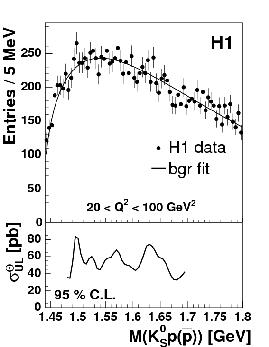
Search for a Narrow Baryonic Resonance Decaying to K0p or K0p in Deep Inelastic Scattering at HERA |

Recently several experiments reported evidence of an exotic baryon, made up from 5 quarks, the strange pentaquark Θ+. This baryon was observed in the decay channels K+n and K0sp. H1 used the latter decay channel to search for this particle, exploring the good track reconstruction capabilities of the detector. The search was made in the DIS regime with the data sample collected in the years 1996-2000.
This exotic baryon has been reported with masses in the range of 1520 to 1540 MeV and with a narrow width, consistent with the experimental resolution in most of the observations. H1 carried out the search in the mass region from 1480 to 1700 MeV with the assumption that the width of the resonance is small and limited by the experimental resolution. While the K0s was identified via the subsequent decay to charged pions, the proton (antiproton) was identified via the measurements of the ionisation energy loss (dE/dx) in the tracker. In total 133000 K0s candidates were reconstructed with only 3% background under the K0s peak. The efficiency of the proton selection varies between 65% and 100% and was tested using protons from Lambda decays.
No signal from a narrow resonance was observed in the mass range from
1480 to 1700 MeV. With the assumption that the resonance is produced
with kinematics similar to those of known strange baryons,
mass-dependent
upper limits at 95% confidence level on the production cross section
are derived.
The figure shows the combined
mass spectra of K0sp and K0sp
in the studied mass range. The upper limit on the cross section is shown
as a curve in the lower plot.
The invariant mass spectra
are also studied separately for K0sp and K0sp.
No narrow
resonance is observed here either.